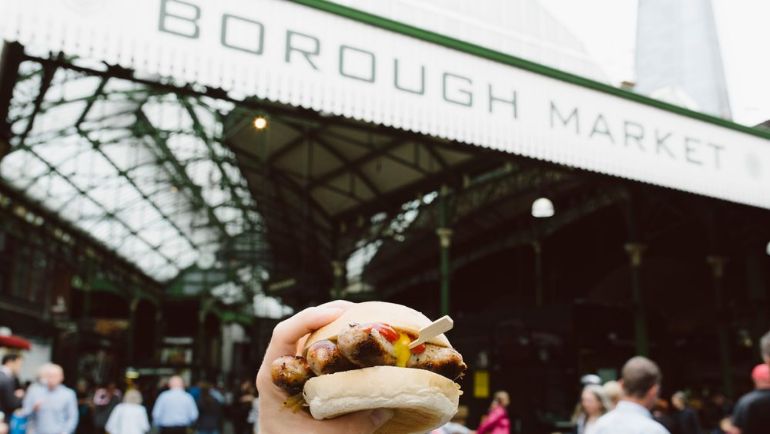The growth of food halls has exploded in recent years, with research suggesting the market will grow to $71.68 billion by 2026. Get ready for more food halls, coming to a city near you.
The big question: How do you get involved in one?
This article covers everything you need to know about food halls, including:
- What a food hall is (i.e. definitely NOT a food court)
- When food halls became popular
- Examples of thriving food halls in Chicago and New York
- Why food halls are so popular
- How you can participate
What Is a Food Hall?
A food hall is a sprawling market that showcases a variety of local mini-restaurants, food vendors, and one or two food-focused shops, all under one roof. You can also expect to find bars, a butchery, various activities, and live music.
Unlike food courts – which are located in shopping malls and often consist of a collection of fast food chains – food halls are often in urban (remodeled) warehouses or ground floors of mixed-use buildings and focus on local rather than chain restaurants. Food is usually prepared fresh to order – no heat lamps here.
These halls are flipping the old food court model on its head. Food is no longer an amenity but the main reason why people visit these areas.
When Did Food Halls Become Popular?

Although food halls have been around for awhile, they’ve only recently stepped into the spotlight. In 2010, there were just 25 halls in the entire U.S., but by 2015 that number had more than doubled to over 50.
From there, growth only accelerated. At the end of 2017, there were 118 across the entire country and, one year later, that number is closer to 180. Based on this growth, some predict the number will explode to 300 by 2020.
Why Are Food Halls So Popular?
Food halls represent the same kind of shift that came with food trucks in 2008, when people wanted to move away from larger chains in search of something unique but still fast and affordable. A changing food culture, rising labor costs, skyrocketing urban rent, and the growing realization from retailers that food attracts people – these are all playing a role in the rise of food halls.
The inherent success of food halls is also fuelling this growth — only three have failed out of the more than 100 that have opened across the U.S.
When you think about the many benefits for customers, retail developers, and restaurants, such an incredible level of success shouldn’t be all that surprising.
Where Can I Find Food Halls?
It seems like food halls are popping up in every state and city, with some already constructed or under construction in the major food scenes of New York, Chicago, Philadelphia, San Francisco, and Los Angeles, as well as smaller cities like Austin, Plano, Portland, Maine, and Omaha.
Below are just some of the many food halls in Chicago and New York.
Food Halls in Chicago:
- Time Out Market, West Loop
- Revival Food Hall, Loop
- Wells St. Market, Loop
- Eataly, River North
- Chicago French Market, West Loop
- Forum 55, Loop
- Latinicity, Loop
- 3 Greens Market, River North
- Foodlife, Magnificent Mile
Food Halls in New York City:
- TurnStyle, Columbus Circle
- The Plaza Food Hall, 1 W 59th St
- Gotham West Market, 600 11th Ave
- City Kitchen, 700 8th Ave
- Urbanspace Vanderbilt, 230 Park Avenue
- Great Northern Food Hall, 89 E 42nd St
- The Pennsy, 2 Pennsylvania Plaza
- Chelsea Market, 75 9th Ave
- Gansevoort Market, 353 W 14th St
- The Bowery Market, 348 Bowery
- Canal Street Market, 265 Canal St
- Hudson Eats, 225 Liberty St
- Gotham Market at The Ashland, 590 Fulton St, Brooklyn
- Berg’n, 899 Bergen St, Brooklyn
- Industry City, Brooklyn
- Urbanspace at 570 Lex, General Electric Building, 570 Lexington Ave
- North 3rd Street Market, 103 N 3rd St, Brooklyn
- Dekalb Market Hall, Basement Level of City Point, 445 Albee Square W, Brooklyn

The Many Benefits of Food Halls
For Customers:
What draws the average person to a food hall? Check out some of the top benefits for customers.
- Unique food experiences: There are many food vendors and types of cuisine available, which appeal to customers who crave artisanal food experiences.
- A world of choice: Customers can choose from a wide variety of food and drinks.
- Convenience: Diners can access this vast assortment of food under roof, which means they don’t have to shop around for instant gratification.
- Atmosphere: With live music and other activities, food halls provide a vibrant ambience.
- Affordability: Diners know they can purchase tasty dishes at prices that won’t break the bank.
- Novelty: For many, the sheer novelty of the experience – culinary browsing, along with the atmosphere – provides more than enough appeal.
For Retail Developers:
Why would retail developers want to get involved in food halls? Here are a few of their favorite things…
- Increased revenue: Retail developers can use food halls to anchor the ground floor of their buildings to drive more leases and, in turn, more money.
- Higher chance of success: Having many food vendors in one space means one struggling concept doesn’t doom the entire operation.
- Real estate value: Food halls increase the value of nearby buildings. For example, one of the main reasons Google bought the building that houses the Chelsea Market was because the market was a valuable nearby amenity for their employees.
For Participating Restaurants
If you’re wondering why you should get involved with a local food hall as part of your marketing plan, check out these benefits:
- Lower costs: Startup costs are lower than opening a standalone restaurant. One of the reasons for the lower cost is that many landlords provide the foundation for your mini-restaurant: fixtures, furniture, and equipment. You just have to customize your stand.
- Shared expenses: Many costs, like general maintenance, are shared across all tenants.
- Exposure: Food halls provide a platform that gives you more exposure, without additional marketing efforts.
- Consistent foot traffic: The variety of vendors, live music, and activities guarantee a high volume of consistent foot traffic. This consistency eliminates some of the uncertainty of not knowing how much business you’ll do.
- Infrastructure: Markets provide power and plumbing – one less thing to worry about (and pay for).
- Less risk: The above benefits mean there’s a lower risk for getting started or trying out new ways to grow your current restaurant.
- Getting started: You can set up shop faster because you have a foundation, fewer things to worry about, and require less upfront capital.
- Shorter contracts: Contracts are shorter compared to standalone restaurants. These contracts offer flexible terms so you can leave before the end of the period without penalties – ideal if things just don’t work out (contracts are discussed more in the next section).
Add a food hall to your marketing plan:
How Do You Participate in a Food Hall?
Below is a five-step process to get involved:
Step 1: Consider the Pros and Cons
While you may understand the many benefits of food halls, there are drawbacks. Compare the below cons against the pros to help you make an informed decision about whether to get involved:
- Some feel that the rapid growth of food halls are diluting their appeal.
- Other problems include crowded spaces, long lines, inability to control the ambiance (the vibe may not match your restaurant’s brand), and sensory overload. This sensory overload can cause decision fatigue for customers – too much choice becomes no choice at all.
These cons suggest there may be a saturation point where halls lose their appeal and customers return to quiet restaurants. The big question, if there is a saturation point, when will we reach it? How many food halls is too many?
Step 2: Know What to Expect – Contracts, Rent Calculations, and Financial Assessments
Each hall will have different rules, regulations, and contractual stipulations. While these details may differ, there are similarities in how landlords structure contracts, calculate rent, and conduct financial assessments.
1. Your food hall contract will probably be a license (and not a lease)
Most food hall contracts will be a license and not a lease. Licenses are shorter, less complex documents that don’t require you to get a lawyer’s review (although a legal review is never a BAD idea). These licenses are usually valid for anywhere from one to three years, whereas standalone restaurant leases remain valid for up to 10.
As mentioned earlier, landlords structure these licenses to give you the flexibility to opt out. Landlords, in turn, have the freedom to rotate vendors who aren’t doing well.
These licenses typically include:
- Rent costs
- Term of license
- Termination clauses
- Dimensions of your stall
- Equipment and amenity inclusions
- Any add-ons, like storage space
- Operating hours
- Non-competes
- List of fees for shared expenses, like common area maintenance charges (either included in your rent or as an extra monthly fee)
2. Your landlord will likely not charge rent per square foot
Landlords typically don’t calculate rent at a cost per square foot like many city storefront rents because the space is just too small. Instead, expect a base rent plus a percentage rent fee – either as a percentage of daily sales or based on a sales threshold.
Some landlords may also include staggered rents. You pay a low monthly rental in year one, followed by gradual increases in year two and three.
So how much can you expect to pay? The prices will vary by location. In Denver, for example, expect to pay roughly $2,000 per month and, in New York, anywhere up to $8,000 for 200 to 300 square feet.
3. Expect a financial assessment
Landlords will conduct a full financial assessment to understand your risk profile. This assessment will include a credit check and analysis of past balance sheets and income statements.
However, the financial check is less important than the actual concept. If a landlord likes your restaurant concept, chances are good they’ll offer you a license.
Step 3: Find a Suitable Food Hall Near You
With roughly 180 food halls across the country, especially the long lists in Chicago and New York, there’s no shortage for you to choose from.
Step 4: Enquire About the Application Process
The application process will vary for each food hall, but you should start by visiting their website to get more information on how to apply.
Chelsea Market, for instance, provides a contact page for leasing inquiries, while Legacy Food Hall in Plano, Texas has an online form to complete which includes a detailed explanation of your “Big Idea.”
Step 5: Review the Details of Your Specific Agreement
Once you’ve gone through the application process and produced the required documents, the final step will be to review your contract. Ensure you examine the details of your agreement with a fine-tooth comb to avoid surprises later on.
Once you’re happy, you can sign on the dotted line and start your food hall journey.
Food halls have seen a rapid rise in recent years and provide many benefits for participating restaurants. Sure, there are challenges to consider before jumping in, but this trend has an upward momentum that could carry you into a successful year ahead.
Add food halls to your marketing plan:
Free job application template for restaurants
Sign up for our free weekly TouchBistro Newsletter







